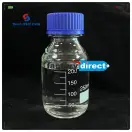-
Categories
-
Pharmaceutical Intermediates
-
Active Pharmaceutical Ingredients
-
Food Additives
- Industrial Coatings
- Agrochemicals
- Dyes and Pigments
- Surfactant
- Flavors and Fragrances
- Chemical Reagents
- Catalyst and Auxiliary
- Natural Products
- Inorganic Chemistry
-
Organic Chemistry
-
Biochemical Engineering
- Analytical Chemistry
-
Cosmetic Ingredient
- Water Treatment Chemical
-
Pharmaceutical Intermediates
Promotion
ECHEMI Mall
Wholesale
Weekly Price
Exhibition
News
-
Trade Service
Speaking of plant protection drones, it is no longer a new term.
During the spring plowing season, there are its figures in the fields across the country, whizzing by, and the liquid medicine is evenly sprayed on the crops to escort food safety
.
Plant protection drones have developed rapidly in recent years and have become the "new darling" of many farmers, so they can't put it down.
What is its charm? 1.
Flexible and convenient: The most common plant protection machines on the market are electric plant protection machines.
They have relatively simple mechanical structure, small size, light weight, and easy folding.
Therefore, they are widely used in the field of plant protection and are favored by farmers
.
2.
Get started quickly: After several years of upgrading, the plant protection drone has become easier and easier to operate.
As long as you can use a smart phone, you can master it after a few days of learning
.
3.
Intelligent and efficient: The electric plant protection machine is bound with electronic software.
You only need to set the flight parameters on the mobile APP, and the drone can start fully autonomous spraying, one-click take-off, return to flight, and return to the breakpoint every time.
It operates about 100 acres per hour, and can fly during the day and night, which is dozens of times more than manual
.
4.
Precise spraying: The basic RTK positioning system used by drones nowadays can reach centimeter-level positioning to avoid re-spraying and missing spraying.
With the addition of a centrifugal nozzle, the liquid medicine can be atomized into micron-sized particles with the help of the downward pressure of the propeller.
The wind field ensures the uniform distribution of the liquid medicine and realizes precise spraying
.
5.
Wide range of operations: UAVs are basically applicable where there are crops, such as wheat, rice, peanuts, tea, and also high crops: corn, cotton, fruit trees.
It reduces the probability of poisoning when spraying pesticides, and saves more than 30% of pesticides and more than 60% of water per mu of land, which can effectively reduce the pollution of pesticides to the environment
.
Just like a harvester instead of a sickle, the plant protection industry is gradually replacing manual spraying.
With the rapid development of the plant protection industry, its advantages are not limited to this, and it is getting closer to the needs of farmers.
I believe it will be more in the future.
Amazing performance
.
During the spring plowing season, there are its figures in the fields across the country, whizzing by, and the liquid medicine is evenly sprayed on the crops to escort food safety
.
Plant protection drones have developed rapidly in recent years and have become the "new darling" of many farmers, so they can't put it down.
What is its charm? 1.
Flexible and convenient: The most common plant protection machines on the market are electric plant protection machines.
They have relatively simple mechanical structure, small size, light weight, and easy folding.
Therefore, they are widely used in the field of plant protection and are favored by farmers
.
2.
Get started quickly: After several years of upgrading, the plant protection drone has become easier and easier to operate.
As long as you can use a smart phone, you can master it after a few days of learning
.
3.
Intelligent and efficient: The electric plant protection machine is bound with electronic software.
You only need to set the flight parameters on the mobile APP, and the drone can start fully autonomous spraying, one-click take-off, return to flight, and return to the breakpoint every time.
It operates about 100 acres per hour, and can fly during the day and night, which is dozens of times more than manual
.
4.
Precise spraying: The basic RTK positioning system used by drones nowadays can reach centimeter-level positioning to avoid re-spraying and missing spraying.
With the addition of a centrifugal nozzle, the liquid medicine can be atomized into micron-sized particles with the help of the downward pressure of the propeller.
The wind field ensures the uniform distribution of the liquid medicine and realizes precise spraying
.
5.
Wide range of operations: UAVs are basically applicable where there are crops, such as wheat, rice, peanuts, tea, and also high crops: corn, cotton, fruit trees.
It reduces the probability of poisoning when spraying pesticides, and saves more than 30% of pesticides and more than 60% of water per mu of land, which can effectively reduce the pollution of pesticides to the environment
.
Just like a harvester instead of a sickle, the plant protection industry is gradually replacing manual spraying.
With the rapid development of the plant protection industry, its advantages are not limited to this, and it is getting closer to the needs of farmers.
I believe it will be more in the future.
Amazing performance
.







